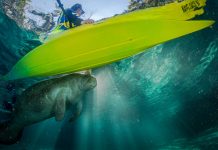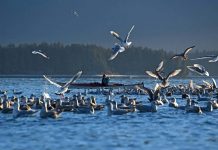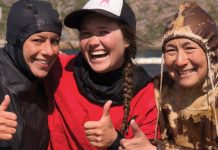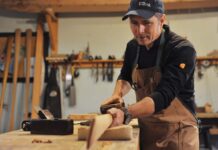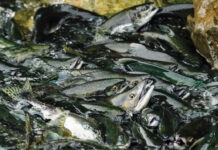AT THE GREENLAND NATIONAL KAYAKING Championships in Sisimiut there were all sorts of events. It’s kind of like a low-key Olympics for Greenland kayak junkies. There are races, rope gymnastics, harpoon throwing, kayak rolling and solo competitions. You get the idea. One of the categories that rarely receives much attention is the category for female group rolling. Each paddler has to complete a specific maneuver for each roll to count. Given there are 30 some-odd ways to roll a kayak in the Greenland National Kayaking Champion ships rule book, it’s a tall order for any paddler.
This year no town, team or country had enough female competitors who felt like doing the team-rolling event. Competing in the solo event, I earned the highest rolling score of any man or woman at the competition. An elderly Greenlander with smiling eyes came up to me and suggested in broken English that I should try and form a women’s team for the next day’s event. I decided to take the old man’s advice and make an international women’s rolling team— just for the fun of it.
Kayak rolling originated in Greenland. The only place to learn is the iceberg-filled water. I learned very few people know how to swim. It is a small country with a population of only about 56,000. That works out to be fewer people than my hometown of Bellingham, Washington. In 2015, they built the country’s first swimming pool. Our northwestern coastal waters are warm and swimming pools are an afterthought. The irony was not lost on me that kayaking proficiency requires much more determination in Greenland than my home in the United States.
Travelling to a foreign country where you cannot communicate is challenging. I understand how it is hard to connect—to bridge the language and cultural barriers—when everyone else is with their home team from a small village, somewhere on the southwest coast of Greenland.
The three women who came together didn’t speak the same language. The kayak connected our different countries and varied dialects. We all love, live and breathe kayaking. Sandie Desbois, on the left, speaks French. From our stilted conversations, I understood she teaches physical education in a public school. She was in Greenland for her summer break. Angerlaq Andersen Olsen, on the right, is one of the best Greenlandic female rollers in the world and sadly, with our limited words, I couldn’t quite grasp what she does for a living. As for me? Growing up with Pygmy Kayaks has allowed for snippets in time like this to occur as I travel capturing photographic moments and writing about adventuring on land and water.
“Three women laughing and playing on the water, speaking the language of the kayak”
As we sat on the water in our kayaks, we mimed the rolls, asking each other if we knew them. Then we would practice and practice—and practice. If we succeeded or not, the success or failure was met with cheers and unbridled enthusiasm. We cheered and coached each other. The crowd egged us on. There was no me against her, no my country against yours, no who is the best. It was just three women laughing and playing on the water, speaking the language of the kayak.
This moment was the highlight of my trip. This was why I had come thousands of miles with my boat: to connect and share and laugh. Afterwards, Angerlaq asked if I would like to try rolling in her traditional sealskin Tulic. I was ecstatic. As the cool, silky sealskin slipped over my head and they tightly tied my wrists and face and deck into the boat, I felt an overwhelming sense of gratitude. It is hard to recount the opportunities the kayak has given me. How it has taken me into wild places all over the world. It is the language we speak that makes us all sisters of the paddle.
Freya Fennwood is an Oregon-based photographer and sea kayaker. She and her partner, Leif Whittaker, are on a Books and Boats tour to promote Leif’s new memoir and Pygmy Kayaks. You can follow her at fennwoodphotography.com. This article originally appeared in the Early Summer 2017 edition of Adventure Kayak.

Subscribe to Paddling Magazine and get 25 years of digital magazine archives including our legacy titles: Rapid, Adventure Kayak and Canoeroots.



